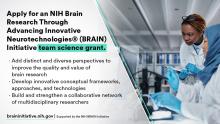
The next application deadline for the BRAIN Initiative®: Research Opportunities Using Invasive Neural Recording and Stimulating Technologies in the Human Brain (U01 Basic Experimental Studies with Humans Required) is September 23, 2022.
The BRAIN Initiative® aims to revolutionize our understanding of the human brain. One area of focus for the BRAIN Initiative seeks to understand the circuits and patterns of neural activity that give rise to mental experience and behavior, which will provide a foundation for understanding and treating diverse neurological, psychiatric, and behavioral disorders.
The BRAIN Initiative: Research Opportunities Using Invasive Neural Recording and Stimulating Technologies in the Human Brain (U01 Basic Experimental Studies with Humans Required) [RFA-NS-22-041] notice of funding opportunity (NOFO) seeks applications to assemble diverse, integrated, multi-disciplinary teams to investigate high impact questions in human neuroscience.
What do I need to know to apply?
Projects should:
- Maximize opportunities to conduct in vivo human neuroscience research made available by direct access to the brain from invasive surgical procedures.
- Be guided by specific theoretical constructs and quantitative, mechanistic models where appropriate.
Awardees will join a consortium work group, coordinated by the National Institutes of Health, to identify consensus standards of practice, including neuroethical considerations, to collect and provide data for ancillary studies, and to aggregate and standardize data for dissemination among the wider scientific community.
Activities Supported
The list below includes representative, but not exhaustive, examples of activities that could be considered responsive to this NOFO:
- Direct intracranial recording and/or stimulation.
- Experimental use of clinical interventions such as tract transections.
- Propose statistically powered hypothesis testing.
- Integrate non-invasive technologies to image and/or perturb the nervous system for use in conjunction with the invasive implants in order to cross spatial and temporal scales.
- Combine multi-modal techniques.
- Offer a combination of quantitative psychophysics and behavioral assays in combination with brain recording or stimulating that test mechanistic hypotheses. Behavioral assays with time resolution comparable to neural recording assays are strongly encouraged.
- Utilize approved, chronic implants (e.g., DBS implants; FDA-approved indwelling electrodes) to address mechanistic hypotheses about brain function, plasticity, etc.
This NOFO also requires a Plan for Enhancing Diverse Perspectives (PEDP). Please see the PEDP guidance material. The next application due date is September 23, 2022. For more information, please view the full NOFO RFA-NS-22-041.
This NOFO is a reissue of RFA-NS-19-001 and part of a family of funding opportunities associated with “Integrated and Quantitative Approaches to Understanding Circuits” and “Investigative Human Neuroscience” designed to explore the circuit basis of behavior using cutting-edge approaches across a variety of species. Examples of projects funded under the previous version of this NOFO (RFA-NS-19-001, RFA-NS-18-010) include research to understand memory consolidation during sleep, how speech is encoded across human language, and understanding how the brain generates movements in the service of better neural prosthetics.
